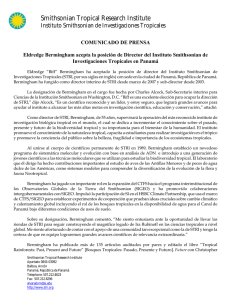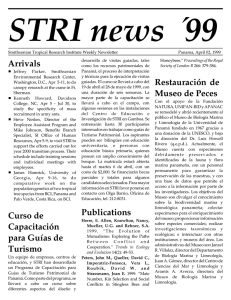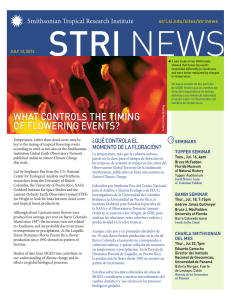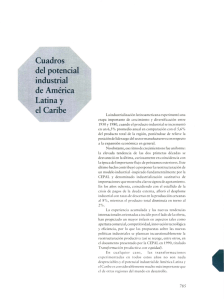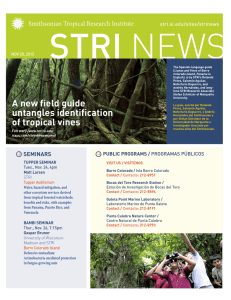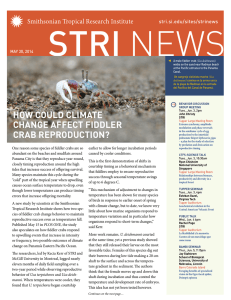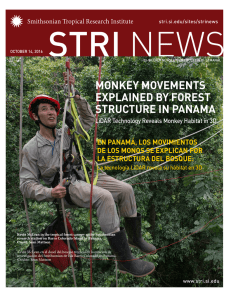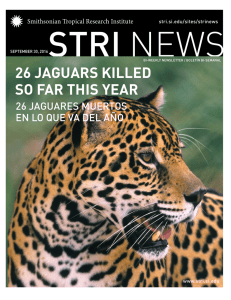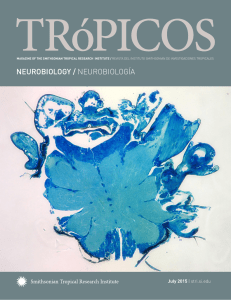4,000-year-old shaman`s stones discovered near Boquete, Panama
Anuncio
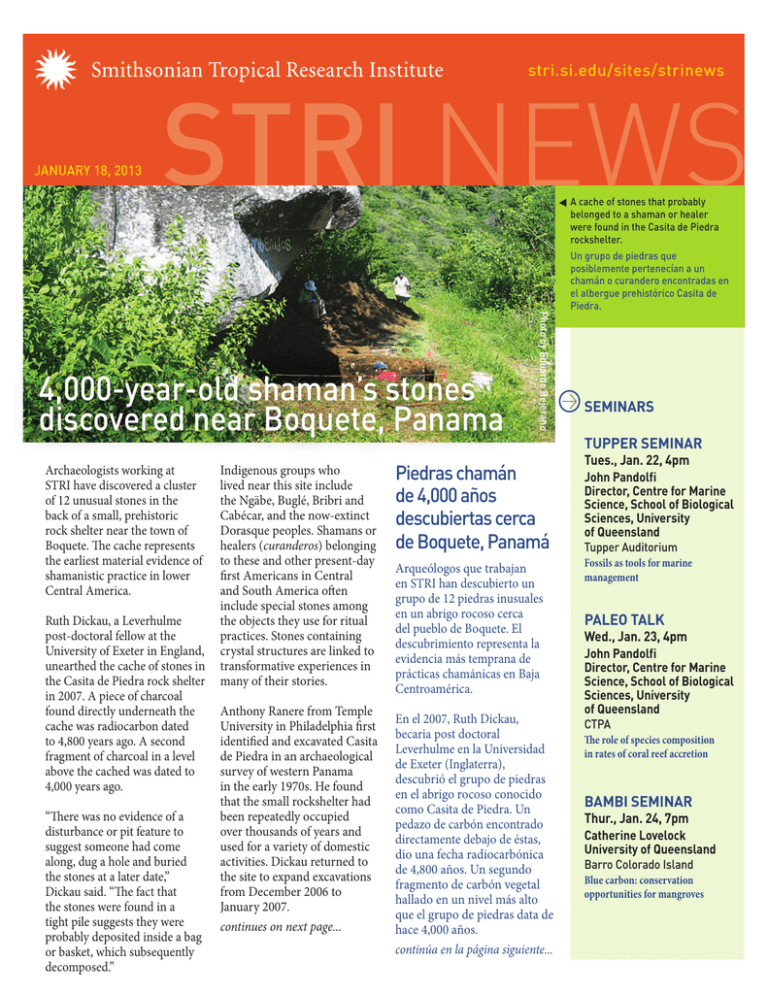
STRI NEWS stri.si.edu/sites/strinews JANUARY 18, 2013 A cache of stones that probably belonged to a shaman or healer were found in the Casita de Piedra rockshelter. Archaeologists working at STRI have discovered a cluster of 12 unusual stones in the back of a small, prehistoric rock shelter near the town of Boquete. The cache represents the earliest material evidence of shamanistic practice in lower Central America. Ruth Dickau, a Leverhulme post-doctoral fellow at the University of Exeter in England, unearthed the cache of stones in the Casita de Piedra rock shelter in 2007. A piece of charcoal found directly underneath the cache was radiocarbon dated to 4,800 years ago. A second fragment of charcoal in a level above the cached was dated to 4,000 years ago. “There was no evidence of a disturbance or pit feature to suggest someone had come along, dug a hole and buried the stones at a later date,” Dickau said. “The fact that the stones were found in a tight pile suggests they were probably deposited inside a bag or basket, which subsequently decomposed.” Indigenous groups who lived near this site include the Ngäbe, Buglé, Bribri and Cabécar, and the now-extinct Dorasque peoples. Shamans or healers (curanderos) belonging to these and other present-day first Americans in Central and South America often include special stones among the objects they use for ritual practices. Stones containing crystal structures are linked to transformative experiences in many of their stories. Anthony Ranere from Temple University in Philadelphia first identified and excavated Casita de Piedra in an archaeological survey of western Panama in the early 1970s. He found that the small rockshelter had been repeatedly occupied over thousands of years and used for a variety of domestic activities. Dickau returned to the site to expand excavations from December 2006 to January 2007. continues on next page... Photo by Eduardo Bejerano 4,000-year-old shaman’s stones discovered near Boquete, Panama Piedras chamán de 4,000 años descubiertas cerca de Boquete, Panamá Un grupo de piedras que posiblemente pertenecían a un chamán o curandero encontradas en el albergue prehistórico Casita de Piedra. SEMINARS TUPPER SEMINAR Tues., Jan. 22, 4pm John Pandolfi Director, Centre for Marine Science, School of Biological Sciences, University of Queensland Tupper Auditorium Arqueólogos que trabajan en STRI han descubierto un grupo de 12 piedras inusuales en un abrigo rocoso cerca del pueblo de Boquete. El descubrimiento representa la evidencia más temprana de prácticas chamánicas en Baja Centroamérica. Fossils as tools for marine management En el 2007, Ruth Dickau, becaria post doctoral Leverhulme en la Universidad de Exeter (Inglaterra), descubrió el grupo de piedras en el abrigo rocoso conocido como Casita de Piedra. Un pedazo de carbón encontrado directamente debajo de éstas, dio una fecha radiocarbónica de 4,800 años. Un segundo fragmento de carbón vegetal hallado en un nivel más alto que el grupo de piedras data de hace 4,000 años. continúa en la página siguiente... CTPA PALEO TALK Wed., Jan. 23, 4pm John Pandolfi Director, Centre for Marine Science, School of Biological Sciences, University of Queensland The role of species composition in rates of coral reef accretion BAMBI SEMINAR Thur., Jan. 24, 7pm Catherine Lovelock University of Queensland Barro Colorado Island Blue carbon: conservation opportunities for mangroves This research project was authorized by Panama’s National Institute of Culture and funded by the Smithsonian and the Social Sciences and Humanities Research Council of Canada. de la página anterior... “No hay evidencia de que alguien haya cavado un hoyo para enterrar las piedras en una fecha posterior,” comenta Dickau. “El hecho de que las piedras se econtraran juntas y apretadas sugiere que probablemente se depositarion dentro de una bolsa o canasta, que luego se descompuso. Anthony Ranere de la Universidad Temple en Filadelfia identificó y excavó Casita de Piedra por primera vez durante un reconocimiento arqueológico en el oeste de Panamá a inicios de los años 70. Descubrió que el pequeño abrigo de piedra fue ocupado en repetidas ocasiones por miles de años siendo utilizado para una variedad de actividades domésticas. Dickau volvió al sitio con el fin de ampliar las excavaciones de diciembre del 2006 a enero del 2007. Dickau volvió al sitio para expandir las excavaciones de diciembre del 2006 a enero del 2007. El grupo de Dickau utilizó el método del carbono-14 para fechar carbón vegetal hallado en los niveles más profundos del abrigo rocoso y descubrió que éste fue ocupado por primera vez hace más de 9,000 años, mucho antes de lo originalmente propuesto por Ranere. La investigación de Ruth demostró además que las personas que se habrían beneficiado del conocimiento Consulting geologist Stewart Redwood determined that the stones consist of a small dacite stone fashioned into a cylindrical tool; a small flake of white, translucent quartz; a bladed quartz and jarosite aggregate; a quartz crystal aggregate; several pyrite nodules that showed evidence of use; a small, worn and abraded piece of chalcedony; a magnetic andesite flake; a large chalcedony vein stone; and a small magnetic kaolinite stone naturally eroded into an unusual shape, similar to a flower. Stewart Redwood, geólogo consultor determinó que el conjunto consistía en una pequeña piedra de dacita modelada en forma de herramienta cilíndrica, una pequeña hojuela de cuarzo blanco traslúcido, un cristal de cuarzo afilado, un conglomerado de jarosita, un conglomerado de cristales de cuarzo, varios nódulos de pirita que mostraron evidencia de uso, un pedazo erosionado y desgastado de calcedonia, una hojuela de andesita magnética, una piedra grande con una vena de calcedonia y una pequeña piedra de caolinita magnética erosionada de manera inusual, parecida a una flor. Ruth Dickau (right) discovered the rock shelter was first occupied more than 9,000 years ago, much earlier than Anthony Ranere (left) estimated previously. Ruth Dickau (der.) descubrió que el albergue prehistórico fue inicialmente ocupado hace 9,000 años, mucho antes que Anthony Ranere (izq.) estimara anteriormente. del chamán practicaban agricultura a pequeña escala. Esta investigación financiada con fondos del Smithsonian y el Consejo Canadiense de Ciencias Sociales e Investigación de la Humanidad, fue autorizada por el Instituto Nacional de Cultura de Panamá. Based on the placement and the unusual composition of the stones in the cache, Richard Cooke, a STRI staff scientist, suggested that were used by a shaman or healer. Photo by Drude Molbo Cerca de este sitio vivieron grupos indígenas como los ngäbe, buglé, bribrí y cabécar, y los ya extintos dorasque. Los chamanes o curanderos pertenecientes a estos y otras étnias indígenas en Centro y Sur América a menudo incluían piedras especiales entre los objetos que utilizaban en prácticas rituales. Las piedras que contienen estructuras de cristal están ligadas a experiencias transformadoras en muchas de sus historias. Photo by Drude Molbo from previous page... Dickau’s group radiocarbon dated charcoal from the base levels of the shelter and discovered it was first occupied more than 9,000 years ago, much earlier than Ranere originally proposed. Her research also showed that the people who would have benefitted from the shaman’s knowledge practiced smallscale farming. Basados en la colocación y la composición inusual de las piedras encontradas, Richard Cooke, arqueólogo investigador del Instituto Smithsonian en Panamá, sugirió que pudieron haber sido utilizadas por un chamán o curandero. The 6th Annual Meeting of the Global Plants Initiative was held at STRI from Jan. 7-11. La 6ta Reunión Anual de la Iniciativa Global de Plantas se llevó a cabo en el Smithsonian de Panamá del 7 al 11 de enero. Photo by Jaén The Future of the Global Plants Initiative Botanists and database managers met in Panama for the 6th Annual Meeting of the Global Plants Initiative from Jan. 7-11, 2013. Because every plant species name is ultimately based on a unique herbarium specimen called a “type,” GPI’s goal is to facilitate plant identification by posting high resolution scans of all the type specimens in the world on JSTOR, a scholarly internet database. During the four-day meeting, the most pressing item of business was the future of the partnership now that most type specimens have been scanned. Discussions included the design of a fee structure to pay for the addition of new type specimens, while at the same time ensuring easy access to the information by botanists from both wealthy and less wealthy institutions. At the final gathering at Punta Culebra Nature Center, STRI Director Eldredge Bermingham presented Don Randel, Bill Robertson, Doreen Tinajero and Sydney Gilbert from the Andrew W. Mellon Foundation with a 54-page visual history book celebrating 10 years of support for GPI. He also presented them with a bibliography of the 1,000 plus publications resulting from additional Mellon support for more than 100 scholars at STRI who have advanced the discovery of new botanical knowledge in the region. This ambitious project began in Africa in 2003 with funds from the Mellon Foundation and is now coordinated by STRI’s Gloria Jované and Nelly Florez. Herbarium staff from 263 institutions in 73 countries contribute nearly 7,500 new images to the database each week. Currently, 1.5 million type and historical specimens along with other artwork and reference material bring the total to 2 million images. El futuro de la Iniciativa Global de Plantas Botánicos y administradores de bases de datos se congregaron en Panamá para la 6ta Reunión Anual de la Iniciativa Global de Plantas del 7 al 11 de enero de 2013. Como cada nombre de especie de planta está basado en un espécimen único de herbario llamado “tipo,” la meta de GPI es facilitar la identificación de plantas al publicar imágenes digitales de alta resolución de todos los tipos de especímenes en el mundo en JSTOR, una base de datos académica en Internet. Durante la reunión de cuatro días, la prioridad a tratar fue el futuro de la alianza ahora que la mayoría de los tipos de especímenes han sido escaneados. Estas conversaciones incluyeron el diseño de una estructura de tarifas para pagar por la adición de nuevos tipos de especímenes, a la vez que se asegura un fácil acceso a la información por botánicos tanto de instituciones con recursos abundantes o escasos. Durante la reunión de clausura en el Centro de Naturaleza de Punta Culebra, Eldredge Bermingham, Director de STRI, presentó a Don Randel, Bill Robertson, Doreen Tinajero y Sydney Gilbert de la Fundación Andrew W. Mellon un libro de 54 páginas de historia visual para celebrar los 10 años de apoyo a GPI. También presentó una bibliografía de las más de mil publicaciones que resultaron del apoyo adicional de Mellon a más de 100 investigadores en STRI quienes han hecho avances en el descubrimiento de nuevos conocimientos botánicos en la región. Este ambicioso proyecto inició en África en 2003 con fondos de la Fundación Mellon y es ahora coordinado por Gloria Jované y Nelly Florez en STRI. El personal botánico de 263 instituciones en 73 países contribuye con cerca de 7,500 nuevas imágenes cada semana. Actualmente, 1.5 millones de especies de tipos y especímenes históricos junto con otros artes y materiales de referencia aportan un total de dos millones de imágenes. How will tropical birds respond to climate change? ¿Cómo reaccionarán las aves tropicales al cambio climático? With dry forests just a crow’s flight from rainforests, closely related bird species have settled different niches in Panama’s diverse habitats. These birds have adapted to their particular ecosystems’ climates, which likely limit their ranges. What will happen if their habitats become drier or wetter on a changing planet? Con bosques secos a solo un vuelo de pájaro de los bosques tropicales, especies de aves cercanamente emparentadas han establecido distintos nichos en los diversos hábitats de Panamá. Estas aves se han adaptado a los climas de sus ecosistemas particulares, lo que probablemente limita su alcance. ¿Qué pasará si sus hábitats se vuelven más secos o húmedos en un planeta cambiante? Nick Sly, a doctoral student from the University of Illinois at Urbana-Champaign, plans to round up birds from contrasting Panamanian habitats and test how they respond to different humidity treatments at STRI’s Gamboa facilities. Nick expects the birds from constant climate conditions to show narrow tolerance to varying humidity in captivity. Nick Sly, estudiante de doctorado de la Universidad de Illinois en Urbana-Champaign planea reunir aves de hábitats contrastados de Panamá y probar cómo responden a los distintos tratamientos de humedad en las instalaciones de STRI en Gamboa. Nick espera que las aves de condiciones climáticas constantes muestren poca tolerancia a las variaciones de humedad en cautiverio. “If that’s true, anything outside that very narrow norm is very stressful, so that is why their ranges are so restricted,” says Nick, who is on the STRI platform with the first Panama semester for the STRI-Illinois Integrative Graduate Education and Research Traineeship (IGERT). His research is being conducted with UI Ph.D. student Phred Benham. “The research helps answer what is going to happen to those birds as the climate shifts and how they are going to react.” “Si esto es cierto, cualquier cosa fuera de la norma estricta es muy estresante, y por eso es que sus alcances están tan restringidos,” dice Nick, quien está en la plataforma de STRI con el primer semestre de IGERT (Entrenamiento Integrador de Educación e Investigación de Post-Grado por sus siglas en inglés). Nick lleva a cabo su estudio con Phred Benham, estudiante de doctorado de UI. “Este estudio ayuda a responderqué pasará a aquellas aves a medida que el clima cambie y cómo reaccionarán”. Photo by Sean Mattson Questions/comments Preguntas/comentarios [email protected] ARRIVALS Leila AtallahBenson Northeastern University Jameal Samhouri NOAA Northwest Fisheries Science Center Field Course - Three OceansNortheastern University 2013 Bocas del Toro Liza Comita STRI’s new Advisory Board meeting Nuevo Comité de Asesores del Smithsonian en Panamá STRI’s new Advisory Board met with Fundacion Smithsonian and STRI staff in Panama on January 8 and 9. Advisory Board members in bold, Fundacion members underlined, staff in italics. El nuevo comité de Asesores del Smithsonian en Panamá se reunió con la Fundación Smithsonian y personal del Instituto el 8 y 9 de enero. (Miembros del comité de Asesores en negrita, miembros de la Fundación subrayados, personal del Instituto en bastardilla) Front row | Primera fila: Lisa Barnett, Frank Levinson, Eva Pell, Eldredge Bermingham, Thomas Tupper. Second row | Segunda fila: Jennifer McMillan, Chimene Longwater, Andrew Altieri, Ira Rubinoff, Eunice Daniels, Tony Coates, Helene MullerLandau, Nicolas Psychoyos, Anna Lisa Porras, Carmen Mullins, Carolina Esquivel, Fernando Porras, Debbie Psychoyos, Pedro Heilbron, Sharon Ryan. Back Row | Fila de atrás: Richard Schooley, Elena Miller, Peter Miller, Steven Hoch, Eric Daniels, S. Joseph Wright, Joseph Fidanque. DEPARTURES Rachel Collin To Bocas del Toro, Panama For a BRS station administration and Development Visit. Carmen Galdames To El Cope La Rica, Cocle. Plant collection and photography of plant species in a remote area with Karina Viquez and Nelson Jaen. Steve Paton To Tempe, Arizona To attend workshops with colleges from Arizona State University and STRI with Mathew Miller and Carlos Caballero. John Christy Carmen Mullins To Panama City and Bocas del Toro Coming from Washington to work with Panama staff. Andrew Altieri To Bocas Station As a guest speaker in IGERT course to be held in Bocas del Toro. Ruth Reina To Bocas del Toro and Chiriqui For Field guide for the project “Estimating diversity of Neotropical monogenean (Platyhelminthes) fish parasites” From 24-27 they will be at Bocas del Toro, from 27-30 at David, Chiriqui. To Steamboat Springs,Colorado To attend the 35th Annual Winter Animal Behavior Congress and present “The exaggeration of a sexual signal not by female choice.” Ana Endara Ana Matilde Ruiz To Portland, Oregon Tower crane inspector training. To Bocas del Toro, Panama. To work with Bocas staff as the logistical event coordinator. To Fortuna Station Photographic and video coverage of the IGERT course for the web page. Jose Ramon Perurena Ohio State University Genetic diversity, resistance genes, and negative density dependence in tropical tree seedling dynamics Sohini Vanjari University of Cambridge The genetics and behavioural basis of speciation in heliconius butterflies Gamboa Gregory Willis and Jacalyn Giacalone Montclair State University Barro Colorado Island mammal census Barro Colorado Island Desmond Foley Smithsonian National Museum of Natural History Mosquito species diversity and landscape change Naos Marine Lab Stephen Yanoviak University of Louisville Ecology and behavior of arboreal arthropods Barro Colorado Island PUBLICATIONS Alda, F., Reina, R. G., Doadrio, I. and Bermingham, E. 2013. Phylogeny and biogeography of the Poecilia sphenops species complex (Actinopterygii, Poeciliidae) in Central America. Molecular phylogenetics and evolution,doi:10.1016/j. ympev.2012.12.012 Engene, N., Gunasekera, S., Gerwick, W. H. and Paul, V. J. 2013. Phylogenetic Inferences reveal large extent of novel biodiversity in chemically rich tropical marine cyanobacteria. Applied and Environmental Microbiology, Januarydoi:10.1128/ AEM.03793-12 Baldeck, C. A., Harms, K. E., Yavitt, J. B., John, R., Turner, B. L., Valencia, R., Navarrete, H., Davies, S. J., Chuyong, G. B., Kenfack, D., Thomas, D. W., Madawala, S., Gunatilleke, N., Gunatilleke, S., Bunyavejchewin, S., Kiratiprayoon, S., Yaacob, A., Supardi, M. N. Nur and Dalling, J. W. 2013. Soil resources and topography shape local tree community structure in tropical forests. Proceedings of the Royal Society B: Biological Sciences, 280(1753) doi:10.1098/ rspb.2012.2532 Knight, K. 2012. Optic flow gives stingless bees impressive vertical accuracy. Journal of Experimental Biology, 215(18): i-iii. doi:10.1242/ jeb.078659 Böhm, M., Collen, B., Baillie, J. E. M., Bowles, P., Chanson, J., Cox, N., Hammerson, G., Hoffmann, M., Livingstone, S. R., Ram, M., Rhodin, A. G. J., Stuart, S. N., van Dijk, P. P., Young, B. E., Afuang, L. E., Aghasyan, A., García, A., Aguilar, C., Ajtic, R., Akarsu, F., Alencar, L. R. V., Allison, A., Ananjeva, N., Anderson, S., Andrén, C., et al. 2013. The conservation status of the world’s reptiles. Biological Conservation, 157: 372-385.doi:10.1016/j. biocon.2012.07.015 Román-Dañobeytia, F. J., Castellanos-Albores, J., LevyTacher, S. I., Aronson, J., RamírezMarcial, N.i and Rodrigues, R. R. 2012. Responses of transplanted native tree species to invasive alien grass removals in an abandoned cattle pasture in the Lacandon region, Mexico. Tropical Conservation Science, 5(2): 192207. Tierney, S. M., Fischer, C. N., Rehan, S. M., Kapheim, K. M. and Wcislo, W. T. 2013. Frequency of social nesting in the sweat bee Megalopta genalis (Halictidae) does not vary across a rainfall gradient, despite disparity in brood production and body size. Insectes Sociaux, doi:10.1007/ s00040-012-0280-4 Wcislo, W. T. 2012. Big brains, little bodies. Science, 338(6113): 1419
